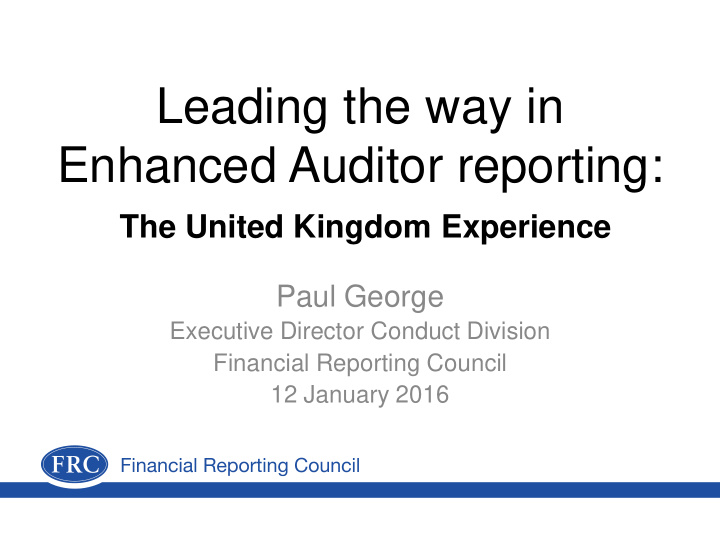



Leading the way in Enhanced Auditor reporting: The United Kingdom Experience Paul George Executive Director Conduct Division Financial Reporting Council 12 January 2016
Presentation outline • About the FRC • Background • Package of changes • Experience to date • Common auditor pitfalls 2
Overview of the FRC • FRC Mission • to promote high quality corporate governance and reporting to foster investment • Supporting strategies of trustworthy information and trustworthy behaviour 3
Overview of the FRC FRC Scope • Corporate governance and stewardship code • Setting accounting, auditing and actuarial standards • Overseeing the accountancy and actuarial professions • Monitoring corporate reporting and audit quality • Operating an independent disciplinary scheme 4
The need for change • Financial crisis highlighted • The need for high quality audit • Relevance of audit • Lack of transparency • Investors expectation that auditors, boards and regulators work together more effectively to identify, assess, mitigate and report on risk • Based on our audit inspections a need to raise quality generally 5
Package of changes • Measures to enhance the management of risk and related corporate reporting • Setting out the business model • Explaining how risk is managed • Fair balanced and understandable • Greater transparency of the work of the Audit Committee • Measures to enhance the relevance of audit • Extended scope of reporting across the annual report • Extended auditor reports • Measures to enhance auditor objectivity and independence • More stringent ethical standards • Retendering 6
Overview of changes Audit Committee Reporting • Significant issues they considered and how they were addressed • How they assessed the effectiveness of the external auditor • Their approach to ensuring auditor independence Changes designed to increase transparency and focus of both the auditor and audit committee on audit quality 7
Overview of changes (2) Auditor Reporting • A description of the assessed risks of material misstatement • Their impact on audit strategy, resources and audit effort • How the auditor applied the concept of materiality • A summary of the audit scope and how it responded to the assessed risks and application of materiality 8
Overview of changes (3) Auditor Reporting (continued) • Changes designed to enable more informed dialogue and public challenge about whether audits meet the legitimate needs of users • Auditors were encouraged to be entity specific and joined up with audit committees 9
Overview of changes (4) Auditor Reporting (continued) • Encouraged individual audit partners to be innovative • No specific examples within the standard • Materiality discussion must specify the threshold used for the financial statements as a whole • Effective for financial years from October 2012 onwards 10
Overview of changes (5) We met with some resistance • Too much responsibility on audit committees • Calls to delay until IAASB standard issued • Insufficient guidance • IAASB highly supportive 11
Experience to date • Benefitted from early adoption by Vodafone • Benefitted from good dialogue and interaction between all stakeholders • Overwhelmingly positive • Auditors surpassed expectations • Differences between and within firms emerged • Investors now read audit reports 12
Reporting of risks • Survey found between 1 and 10 risks reported • Average number higher for FTSE 100 companies • Some included standard risk of material misstatement due to fraud and error, or management override of controls • Most risks by industry sector in Oil & Gas and Telecoms • Granular, specific risks (61% of sample) versus generic risks (39% of sample) 13
Materiality • General requirement in ISA 700 to explain application of the concept of materiality, and specify the threshold used for the financial statements as a whole • ISA 700 also suggests five further matters: Matter suggested Take up in sample (of 153) Materiality for classes of Observed in 5 cases transactions, where it is lower than materiality for the financial statements as a whole Performance materiality With some exceptions, largely by one firm only Significant revisions No examples found Threshold for reporting unadjusted Widespread disclosure differences to the audit committee Significant qualitative considerations No examples found 14
Scope • Assessment of how well scope of audit addresses risks of material misstatement and application of materiality – 56% comprehensive, 24% met requirement, 20% did not fully meet the requirement • Measures used: • Revenue coverage • Total asset coverage • Profit before tax • Use of auditor’s experts • Reference to component auditors 15
Investor feedback • Generally positive as provides a basis for dialogue • Citi Bank research September 2015 • Year 2 an improvement • A need for greater clarity on materiality • Focus on specific rather than generic risks • More ‘Rolls - Royce’ style reports wanted • Disclosure of adjusted and unadjusted audit differences • Further innovation sought 16
Common auditor pitfalls As part of our routine inspections we noted a few teething problems • Inaccurate or imprecise description of the work performed • Use of experts • Testing of controls • Two examples where the scope could be misinterpreted 17
Questions 18
Recommend
More recommend